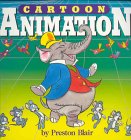 |
CHAPTER
2
CHARACTER MOVEMENT |
Once
the character has been developed, the animator must consider
the types of actions that are appropriate for it. A character's
basic design should contain a sense of movement to convey
a message to the viewer about the character's actions
and intended actions. One way to accomplish this is to
use the "line of action" that is the basis for rhythm,
simplicity, and directness.
This chapter includes rhythm charts for creating movements
of both humans and animals. These charts demonstrate that
not only must the head, legs, arms, and hands move in
proper relation to one another, but also the body mass
must follow. The exercises on page
100 that demonstrate the movements of a man diving
into a pool and of a bouncing ball are excellent examples
of accurate follow-through. Movements within the figure
such as "squashing", "twisting",
and "stretching" are only a few of the movements studied
in this chapter. |
|
|
| An
animation cycle is a series of drawings that take a character through
a complete movement (for instance, a walking step). Complete cycles
for continuous animated movement and the differences in body attitudes
for such movements as running, walking, dancing, posing, and much
more are also included. |
Another
subject introduced in this chapter is adapting a character to
a background. This subject is covered in detail in the "Technical"
chapter, but this introduction is an excellent stepping-stone
to the more complex instructions.
By following the instructions in this chapter, you can make
any character-person, animal, or inanimate object-come to life
through animated movement. It is exciting and great fun to do. |
 |
|
|


